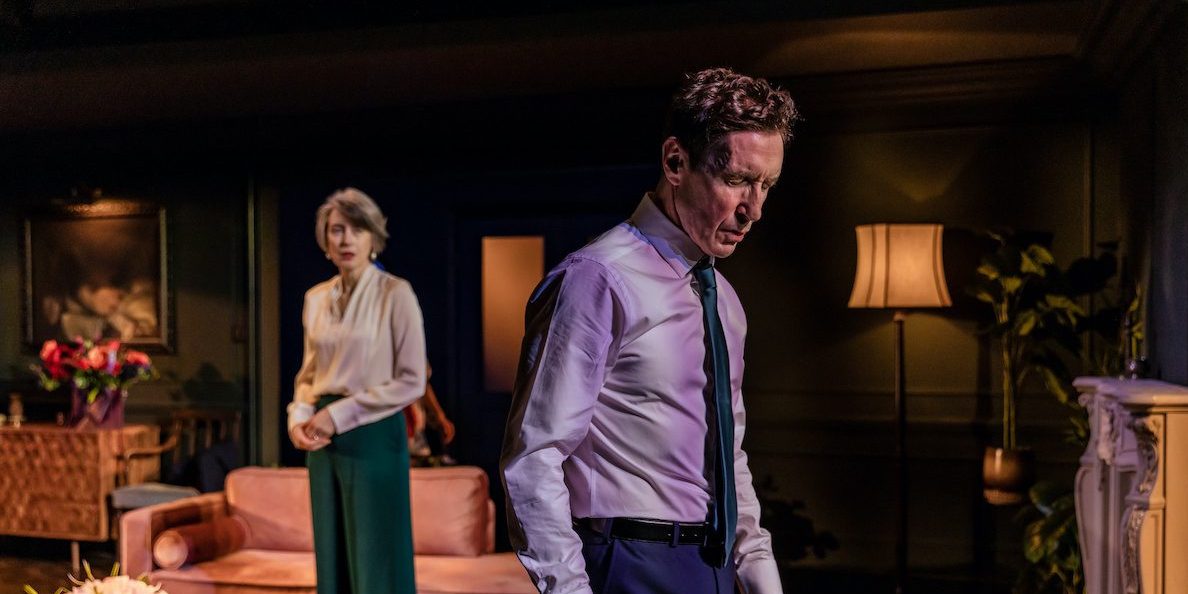This is one of those plays where it does help to read the interviews in the programme. Even more than usual with Florian Zeller this new work opening at the Hampstead Theatre requires the audience to work quite hard to put the plot together, which in fact remains the untrustworthy right to the end. As Zeller says. ‘There is, on the one hand, a man’s mental disintegration, and, on the other, our attempt to find a route towards an understanding of it. My plays often resemble little labyrinths in which we can get lost, and, sometimes, find ourselves.’
What we have here is essentially three iterations. versions or variations on the same theme, essentially a stock plot that is very cleverly tweaked and disrupted. An eminent and successful Parisian surgeon, Pierre, is leading a double life of bourgeois domesticity with his wife of many years while also conducting an affair with an increasingly demanding and dissatisfied mistress. The two halves of his life are in increasing danger of colliding, and as he desperately tries to keep them in their separate compartments his own mind begins to disintegrate under the pressure. As the sequence of scenes is repeated with variations our own knowledge of the narrative is both expanded and complicated while, at the same time, we experience his own collapse of control and coherence.
For the first two outings of the story, this all succeeds exceptionally well thanks to superlative acting by all cast members and a very tight and sophisticated production in the very experienced hands of Jonathan Kent. There are three sets on the stage, designed by Anna Fleischle, illustrating the three aspects of the protagonist’s life – the comfortable, affluent living room he shares with his wife, a ‘chambre de bonne’ in Central Paris where he meets his mistress, and a consulting room/office where he opens up to friends, is interrogated by a ‘man in black’ or plots a solution to his predicament. As the play proceeds these locations and conversations gradually bleed into one another, which creates some fascinating juxtapositions though also some over-blurring in the final section.
Two actors play Pierre, for both practical and dramatic reasons. Both Toby Stephens and Paul McGann are excellent in portraying a suave professional exterior gradually cracking up under the strains and pressures of leading a double life. And the very fact of having two actors helps to emphasise the duplicity and vertiginous role-playing involved. The two central female roles are also excellently played in highly contrasted moods – as the poised, elegant wife Gina McKee is a model of domestic concern and support until her suspicions are aroused when she impressively segues into passive-aggressive silence, including one long, meaningful pause, huge in implications, that is in some ways the culmination of the action. By contrast, Angel Coulby is all emotional extremes, delivered with a fierce intensity, though the final scenes in which she appears to push her character, are far less predictable and fatalistic directions. There are minor roles for a couple of dinner-party guests (Silas Carson and Sakuntala Ramanee) who seem to have escaped from a play by Albee; and also for Pierre’s daughter and son-in-law, whose relationship may be collapsing with interesting echoes of his own. But the most important secondary character is Finbar Lynch’s inquisitor-psychiatrist, daubed in eerie clownish make-up, who is a continual voice of reckoning throughout.
An intermittent and creepy sound scheme by Isobel Waller-Bridge and precisely atmospheric lighting from Hugh Vanstone round out a highly successful evening on the technical side. The fact that for much of the time this feels like a thriller, despite all the potential narrative disruptions, is largely down to such astute choices of direction and suggestive context.
While this is a fascinating evening there is a sense, unlike in his preceding ‘Family’ Trilogy’, that somewhere something is missing. Perhaps it will ultimately work even better on film where there is no need for two actors to play the central role? Or, as my companion said, possibly something is lost in translation, despite the – as usual – expertly skilful work by Christopher Hampton? Or perhaps it is an inherent feature of theme and variation form that – as in music – there is no natural ending, only a decision to stop offering alternative meanings……?

